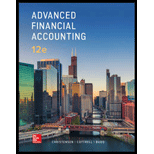
Concept explainers
(a)
Introduction: Consolidation is the process of combining financial results of various subsidiaries with the financial results of parent company. It is used only when parent company holds more than 50% of share of subsidiary company.
The
(a)
Explanation of Solution
Journal entries recorded by B company for its investment in C company is as follows:
| Date | Particulars | Debit ($) | Credit ($) |
| January 1, 20X3 | Investment in C company's stock | 120,000 | |
| To cash | 120,000 | ||
| (Recording entry for purchase of stock of C company by B company) | |||
| December 31, 20X3 | Cash | 9000 | |
| To Investment in C company's stock ($15000*60%) | 9000 | ||
| (Recording entry for receiving dividend from C company) | |||
| December 31, 20X3 | Investment in C company's stock | 24,000 | |
| To Income from C company ($40,000*60%) | 24,000 | ||
| (Recording entry for receiving income from C company on investment) |
(b)
Introduction: Consolidation is the process of combining financial results of various subsidiaries with the financial results of parent company. It is used only when parent company holds more than 50% of share of subsidiary company.
The journal entries recorded by A company for its investment in B company.
(b)
Explanation of Solution
Journal entries recorded by A company for its investment in B company is as follows:
| Date | Particulars | Debit ($) | Credit ($) |
| January 1, 20X3 | Investment in B company's stock | 315,000 | |
| To cash | 315,000 | ||
| (Recording entry for purchase of stock of B company by A company) | |||
| December 31, 20X3 | Cash | 45,000 | |
| To Investment in B company's stock ($50000*90%) | 45,000 | ||
| (Recording entry for receiving dividend from B company) | |||
| December 31, 20X3 | Investment in B company's stock | 129,600 | |
| To Income from B company ($120,000+$24000) *90%) | 129,600 | ||
| (Recording entry for receiving income from C company on investment) |
(c)
Introduction: Consolidation is the process of combining financial results of various subsidiaries with the financial results of parent company. It is used only when parent company holds more than 50% of share of subsidiary company.
The consolidated entries related to B company’s investment in C company and A company’s investment in B company.
(c)
Explanation of Solution
Consolidated entries related to B company’s investment in C company is as follows:
| Date | Particulars | Debit ($) | Credit ($) |
| December 31, 20X3 | Common stock | 100,000 | |
| Additional capital | 60,000 | ||
| 40,000 | |||
| Income from C company | 24,000 | ||
| Non-controlling interest of C company | 16,000 | ||
| To Dividend declared | 15,000 | ||
| To Investment in C company | 135,000 | ||
| Non-controlling interest in Net asset of C company | 90,000 | ||
| (Consolidated entry of investment in C company by B company) |
Working Note:
| Particulars | NCI 40% | B company 60% | = | Common Stock + | Additional Paid-In Capital + | Retained Earnings |
| Original book value | $80,000 | $1,20,000 | = | $1,00,000 | $60,000 | $40,000 |
| + Net Income | $16,000 | $24,000 | = | $40,000 | ||
| - Dividends | ($6,000.00) | ($9,000) | = | ($15,000) | ||
| Ending book value | $90,000 | $1,35,000 | = | $1,00,000 | $60,000 | $65,000 |
Consolidated journal entries related to A company’s investment in B company is as follows:
| Date | Particulars | Debit ($) | Credit ($) |
| December 31, 20X3 | Common stock | 150000 | |
| Additional capital | 60000 | ||
| Retained earnings | 140000 | ||
| Income from C company | 129600 | ||
| Non-controlling interest of B company | 14400 | ||
| To Dividend declared | 50000 | ||
| To Investment in B company | 399600 | ||
| Non-controlling interest in Net asset of B company | 44400 | ||
| (Consolidated entry of investment in B company by A company) |
Working note:
| Particulars | NCI 10% | A company 90% | = | Common Stock + | Additional Paid-In Capital + | Retained Earnings |
| Original book value | $35,000 | $3,15,000 | = | $1,50,000 | $60,000 | $1,40,000 |
| + Net Income | $14,400 | $1,29,600 | = | $1,44,000 | ||
| - Dividends | ($5,000.00) | ($45,000) | = | ($50,000) | ||
| Ending book value | $44,400 | $3,99,600 | = | $1,50,000 | $60,000 | $2,34,000 |
Want to see more full solutions like this?
Chapter 9 Solutions
Advanced Financial Accounting
- Amazon Industries has a break-even point in sales of $920,000, and its variable expenses are 60% of sales. If the company incurred a loss of $27,600 last year, what must have been the actual sales? a) $851,000 b) $890,000 c) $860,000 d) $750,000arrow_forwardWhat is the weighted average cost per unit ?arrow_forwardCan you demonstrate the accurate steps for solving this financial accounting problem with valid procedures?arrow_forward
 Financial Reporting, Financial Statement Analysis...FinanceISBN:9781285190907Author:James M. Wahlen, Stephen P. Baginski, Mark BradshawPublisher:Cengage Learning
Financial Reporting, Financial Statement Analysis...FinanceISBN:9781285190907Author:James M. Wahlen, Stephen P. Baginski, Mark BradshawPublisher:Cengage Learning
